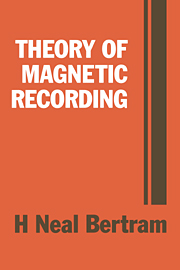Book contents
- Frontmatter
- Contents
- Preface
- 1 Overview
- 2 Review of magnetostatic fields
- 3 Inductive head fields
- 4 Medium magnetic fields
- 5 Playback process: Part 1 – General concepts and single transitions
- 6 Playback process: Part 2 – Multiple transitions
- 7 Magnetoresistive heads
- 8 Record process: Part 1 – Transition models
- 9 Record process: Part 2 – Non-linearities and overwrite
- 10 Medium noise mechanisms: Part 1 – General concepts, modulation noise
- 11 Medium noise mechanisms: Part 2 – Particulate noise
- 12 Medium noise mechanisms: Part 3 – Transition noise
- References and bibliography
- Index
4 - Medium magnetic fields
Published online by Cambridge University Press: 02 February 2010
- Frontmatter
- Contents
- Preface
- 1 Overview
- 2 Review of magnetostatic fields
- 3 Inductive head fields
- 4 Medium magnetic fields
- 5 Playback process: Part 1 – General concepts and single transitions
- 6 Playback process: Part 2 – Multiple transitions
- 7 Magnetoresistive heads
- 8 Record process: Part 1 – Transition models
- 9 Record process: Part 2 – Non-linearities and overwrite
- 10 Medium noise mechanisms: Part 1 – General concepts, modulation noise
- 11 Medium noise mechanisms: Part 2 – Particulate noise
- 12 Medium noise mechanisms: Part 3 – Transition noise
- References and bibliography
- Index
Summary
Introduction
Magnetized recording media produce fields by virtue of divergences in the magnetization pattern. Thus, (2.8) can be utilized to obtain the magnetic fields for any specified magnetization pattern. For two-dimensional geometry it is often convenient to utilize the simple form given by (2.22), or under certain conditions (2.26). Magnetized media are particularly simple to analyze since, in general, they extend infinitely far along the x axis and possess a finite thickness or magnetization depth which does not vary along the x axis. In this section expressions are given for the fields for single magnetization transitions that are either longitudinally or vertically oriented. That discussion will be followed by a general relation for the Fourier transform of the fields. This section is concluded by a discussion of the fields from sinusoidally magnetized media. Only two-dimensional geometries will be considered.
Single transitions
We begin by deriving the fields produced by a single, perfectly sharp transition as sketched in Figs. 4.1(a) and 4.2(a) for a longitudinally and vertically directed magnetization, respectively. The coordinate system (x, y) is centered at the center of the medium at the transition center. Equation (2.26) may be utilized for both cases, since the volume charge for the case of a sharp transition of longitudinal magnetization is equivalent to a surface charge of σ = 2M at the transition center (x = x0) extending from − δ/2 < y < δ/2. The fields for a longitudinal magnetization utilizing (2.26) (r1, r2, θ are noted in Fig. 4.1 (a)) yield:
These fields are plotted versus x for fixed y in Fig. 4.1(b) along the medium centerline (y = 0) and in Fig. 4.2(c) at the medium surface y = δ/2.
- Type
- Chapter
- Information
- Theory of Magnetic Recording , pp. 89 - 106Publisher: Cambridge University PressPrint publication year: 1994



